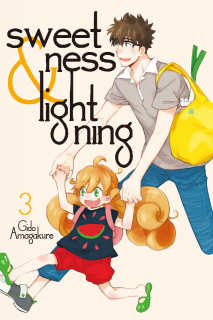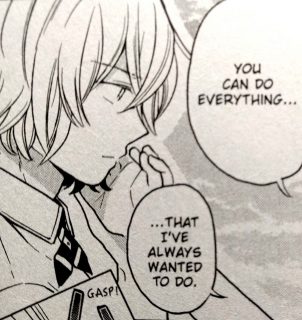My News and Reviews
Last week at Experiments in Manga, the winner of the Queen Emeraldas manga giveaway was announced. The post also includes a list of some of the manga available in English which are at least partially set in space. Otherwise, it was a fairly quiet week. I’m still very busy at work, training for the new job, but things are largely going well on that front. Later this week I’ll be leaving for a long weekend in Toronto for the Toronto Comic Arts Festival, so hopefully I’ll still be able to remember everything that I’ve been learning when I get back.
Elsewhere online, Brigid Alverson recently reported back on manga at the C2E2 conference for Publishers Weekly. The Anime Feminist continues to host interesting features on manga; most recently freelance translator Jenny McKeon took a look at yuri manga. The San Diego Comic-Con is fast approaching which means that this year’s Eisner Award nominations have been announced. As usual, most of the nominated manga are found in the Best U.S. Edition of International Material—Asia category (Goodnight Punpun by Inio Asano, Orange by Ichigo Takano, The Osamu Tezuka Story by Toshio Ban, Princess Jellyfish by Akiko Higashimura, and Wandering Island by Kenji Tsuruta) but Takeshi Obata’s artbook Blanc et Noir was also nominated for Best Comics-Related Book.
Quick Takes
 Cigarette Girl by Masahiko Matsumoto. Although touted as the first collection of Matsumoto’s work in English (which may technically be true), Cigarette Girl is actually the second volume of manga by Matsumoto to be translated. Granted, Cigarette Girl was likely to be the first licensed (it was first announced by Top Shelf back in 2010), but it didn’t end up being released until 2016, two years after The Man Next Door was published by Breakdown Press. Matsumoto, like Yoshihiro Tatsumi (who provides the introduction to Cigarette Girl), worked in the gekiga tradition of manga. Cigarette Girl collects eleven of Matsumoto’s short gekiga manga, originally created for several different magazines in the early 1970s. Most of the stories could be considered romances of one sort or another. While an exploration of love isn’t necessarily the focus of the volume, the manga are all about relationships between people and often those relationships between men and women have a romantic bent to them. The stories in Cigarette Girl tend to be fairly quiet and focus on the everyday life of everyday people, but they’re also rather quirky and surprisingly funny, too. I enjoyed Cigarette Girl a great deal and would definitely be interested in reading more of Matsumoto’s work.
Cigarette Girl by Masahiko Matsumoto. Although touted as the first collection of Matsumoto’s work in English (which may technically be true), Cigarette Girl is actually the second volume of manga by Matsumoto to be translated. Granted, Cigarette Girl was likely to be the first licensed (it was first announced by Top Shelf back in 2010), but it didn’t end up being released until 2016, two years after The Man Next Door was published by Breakdown Press. Matsumoto, like Yoshihiro Tatsumi (who provides the introduction to Cigarette Girl), worked in the gekiga tradition of manga. Cigarette Girl collects eleven of Matsumoto’s short gekiga manga, originally created for several different magazines in the early 1970s. Most of the stories could be considered romances of one sort or another. While an exploration of love isn’t necessarily the focus of the volume, the manga are all about relationships between people and often those relationships between men and women have a romantic bent to them. The stories in Cigarette Girl tend to be fairly quiet and focus on the everyday life of everyday people, but they’re also rather quirky and surprisingly funny, too. I enjoyed Cigarette Girl a great deal and would definitely be interested in reading more of Matsumoto’s work.
 Kiss & White Lily for My Dearest Girl, Volume 1 by Canno. Lately, most of the yuri and other lesbian-themed manga translated in English are currently being released by Seven Seas, but other publishers have been starting to explore (or re-explore) the genre as well. One of Yen Press’ most recent yuri offerings is Canno’s Kiss & White Lily for My Dearest Girl, an ongoing series about the lives and loves of the students at an all-girls school. So far two main couples have been introduced and the short manga between chapter breaks implies that most of the background characters are in one way or another paired off together as well. As for the lead couples, first there is Ayaka and Yurine, the school’s top students. Ayaka is used to being first academically but finds that no matter how hard she tries, Yurine’s natural genius is tough to beat. Yurine, bored with how easy everything is for her, is delighted to finally have someone that she can consider a rival. While Ayaka and Yurine currently have something of a love-hate relationship going on, the affections of the second main couple are much sweeter and more clearly romantic–Ayaka’s tomboyish cousin Mizuki has been in a close relationship with Moe for years.
Kiss & White Lily for My Dearest Girl, Volume 1 by Canno. Lately, most of the yuri and other lesbian-themed manga translated in English are currently being released by Seven Seas, but other publishers have been starting to explore (or re-explore) the genre as well. One of Yen Press’ most recent yuri offerings is Canno’s Kiss & White Lily for My Dearest Girl, an ongoing series about the lives and loves of the students at an all-girls school. So far two main couples have been introduced and the short manga between chapter breaks implies that most of the background characters are in one way or another paired off together as well. As for the lead couples, first there is Ayaka and Yurine, the school’s top students. Ayaka is used to being first academically but finds that no matter how hard she tries, Yurine’s natural genius is tough to beat. Yurine, bored with how easy everything is for her, is delighted to finally have someone that she can consider a rival. While Ayaka and Yurine currently have something of a love-hate relationship going on, the affections of the second main couple are much sweeter and more clearly romantic–Ayaka’s tomboyish cousin Mizuki has been in a close relationship with Moe for years.
 Nichijou: My Ordinary Life, Volumes 1-2 by Keiichi Arawi. I’ve heard great things about Nichijou, both the original manga and it’s anime adaptation and so I was fully expecting to enjoy the series. But while I tend to like absurd humor, for whatever reason the offbeat comedy found in the first two volumes of Nichijou just didn’t work for me. Or at least not consistently. While many of the gags fell flat, there were definitely individual bits that I found to be extremely funny. Some even made me laugh out loud. I was frequently amused by the manga as well as delightfully bemused. But as a whole, Nichijou seems to lack real substance. Granted, that’s not necessarily a bad thing and may very well be part of the point. The series mixes the mundane with the strange and completely unexpected, but that randomness can be difficult to follow at times. On top of the nearly nonexistent narrative logic, action and movement isn’t always conveyed clearly by Arawi’s artwork. As a result, the series’ humor can be difficult to interpret. Even so, Nichijou is admittedly silly and entertaining. But I was very surprised to discover that I didn’t enjoy the manga more than I actually did; it seems like it should haven been a series I loved.
Nichijou: My Ordinary Life, Volumes 1-2 by Keiichi Arawi. I’ve heard great things about Nichijou, both the original manga and it’s anime adaptation and so I was fully expecting to enjoy the series. But while I tend to like absurd humor, for whatever reason the offbeat comedy found in the first two volumes of Nichijou just didn’t work for me. Or at least not consistently. While many of the gags fell flat, there were definitely individual bits that I found to be extremely funny. Some even made me laugh out loud. I was frequently amused by the manga as well as delightfully bemused. But as a whole, Nichijou seems to lack real substance. Granted, that’s not necessarily a bad thing and may very well be part of the point. The series mixes the mundane with the strange and completely unexpected, but that randomness can be difficult to follow at times. On top of the nearly nonexistent narrative logic, action and movement isn’t always conveyed clearly by Arawi’s artwork. As a result, the series’ humor can be difficult to interpret. Even so, Nichijou is admittedly silly and entertaining. But I was very surprised to discover that I didn’t enjoy the manga more than I actually did; it seems like it should haven been a series I loved.
 Sweetness & Lightning, Volumes 3-5 by Gido Amagakure. As I’ve mentioned many times previously, I love food manga and Sweetness & Lightning is no exception. The series is an absolute delight. There’s the food, of course, which I find appealing, but perhaps even more so I enjoy the manga’s focus on friendship and family. Granted, all of this is all tied together in the story–food is what brings people together, creates connections, and deepens relationships. Preparing and sharing a meal is shown as a way of expressing love for another person. Food can also help keep memories alive. Inuzuka keenly feels the loss of his wife and their daughter Tsumugi misses her mother dearly. But as they learn to cook together, recreating family dishes and traditions, they can still be close to her even though she is gone. There are moments of intense sadness but there is also a tremendous amount of joy in Sweetness & Lightning. Amagakure’s illustrations are very expressive, finding an easy balance between these moods. In addition to more exaggerated expressions, the artwork also captures subtle changes. As Tsumugi grows older, for example, her character design matures slightly as well. Sweetness & Lightning is a wonderful series.
Sweetness & Lightning, Volumes 3-5 by Gido Amagakure. As I’ve mentioned many times previously, I love food manga and Sweetness & Lightning is no exception. The series is an absolute delight. There’s the food, of course, which I find appealing, but perhaps even more so I enjoy the manga’s focus on friendship and family. Granted, all of this is all tied together in the story–food is what brings people together, creates connections, and deepens relationships. Preparing and sharing a meal is shown as a way of expressing love for another person. Food can also help keep memories alive. Inuzuka keenly feels the loss of his wife and their daughter Tsumugi misses her mother dearly. But as they learn to cook together, recreating family dishes and traditions, they can still be close to her even though she is gone. There are moments of intense sadness but there is also a tremendous amount of joy in Sweetness & Lightning. Amagakure’s illustrations are very expressive, finding an easy balance between these moods. In addition to more exaggerated expressions, the artwork also captures subtle changes. As Tsumugi grows older, for example, her character design matures slightly as well. Sweetness & Lightning is a wonderful series.

